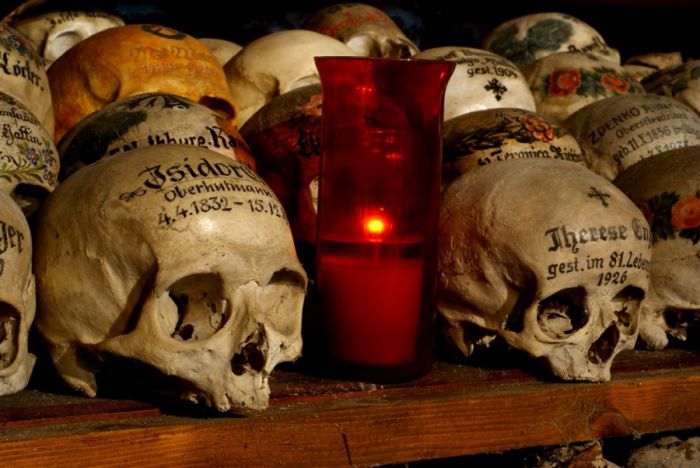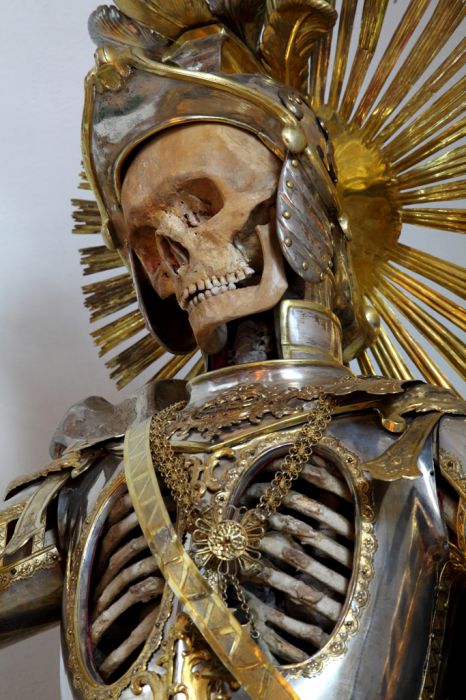After completing his doctorate in art history at UCLA, California State University, Dominguez Hills Art and Design Department lecturer Paul Koudounaris decided to travel a bit. One of his destinations was Melnik, a city near Prague in the Czech Republic, where he visited “The Bone Church,” a 16th ossuary where the skeletal remains of approximately 10,000 people have been meticulously crafted into architectural elements and symbols of the Christian faith.

“It’s an extraordinary place, because it’s very well-arranged with this sophisticated iconography about the Resurrection and salvation,” says Koudounaris. “I spent about three or four hours down there, taking notes about the place.”
When he returned to his hostel, Koudounaris chatted with a man at the front desk, who was unaware of the ossuary. He soon discovered that the Melnik site was virtually unknown to the locals, who were, instead, familiar with a similar site in Sedlec that is a popular tourist attraction.
“This guy … may well have been a descendant of the people whose bones made up those mighty stacks–how can he not have known about this place?” says Koudounaris of his surprise. “I started looking around on the Internet, trying to find more of these places. I became staggered by how many of these places I could come up if I really searched, so I started by visiting a couple.
“I realized at that time that this was an area of research that no one had ever broached,” he says. “My first idea was to travel in one geographic region where there were several of them and make a tour guide to sell in tourist shops. I told my friends that the last thing I was going to do was spend years and years traveling all around the world, working on a book–which in the end, is exactly what I did, because once I got into it, I realized that I couldn’t tell [only] part of the story. The entirety of it had to be put together.”

The result was Koudournaris’s first book, “The Empire of Death: A Cultural History of Ossuaries and Charnel Houses,” which was published this month by Thames and Hudson. Through photographs of sites in a diverse range of locations, such as Germany, Cambodia, the Czech Republic, Ecuador, Egypt, Italy, Peru, and Italy, he provides a comprehensive look at these often misunderstood tributes to the Christian belief and the power of the dead to intercede for the living.
“People see these sites and think of them as sinister or macabre, and they’re not,” says Koudounaris. “These are religious shrines and they’re often not just crypts, but in the churches themselves, and the function of the church is to provide salvation and hope. It’s not to provide a fright.
“The way we interpret death has become so distorted from what it has been in the past,” he continues. “We have lost the context of these that we don’t see them for what they are. The whole skull-and-crossbones motif didn’t start as a memento mori, it didn’t start as something that was meant to be frightening or intimidating. It started as a sign of eschatological hope.”
Koudounaris says that a post-Enlightenment shift of the understanding of the human body and its natural processes and the secular concept of the individual contributed to the end of ossuaries and a halt to what he calls “the dialogue with death.” He also says that the simple matter of public health also was a major factor, as in the history of the Paris catacombs.
“The magnum opus of architecture in human bone is the Paris catacombs… but it’s also the seeds of its own demise,” Koudounaris notes. “The Cemetery of the Innocents, where two million of those bones had come from, had become such a festering cesspool that the ground itself could no longer disintegrate human flesh because [it] was exhausted. Everyone who lived in that neighborhood was getting deathly ill and the ground itself was collapsing. So they put it in this quarry underneath the city and created what we call the Paris catacombs. At the same time, they came up with a new invention, which was the modern cemetery.”
Despite these changes, Koudounaris has been able to discover in his research communities that continue to revere the dead as intermediaries to the divine. He has written extensively on the Bolivian practice of ñatitas, in which people have shirnes to human skulls, which may or may not have belonged to a relative or loved one, and rely on them to help navigate through contemporary life–even in solving crimes.
“People from all walks of life keep these skulls in their homes in little shrines as intercessors, helpers, and protectors and as esteemed members of the family,” says Koudounaris. “I’ve gone to the headquarters of the homicide department in La Paz, where they have two enshrined human skulls, and they pray to them.”

Koudounaris points out that while Bolivians are practicing Catholics, the origins of the ñatitas are largely based on indigenous Andean beliefs. Still, the people persist in combining the two philosophies, to the consternation–and eventual acquiescence of the local clergy.
“On November 8, they take them all down to the cemetery for the Fiesta de las Ñatitas,” he says. “They have them blessed and have this big party for them with traveling musicians. One year, there was a riot when the priests refused to bless the skulls, and 5,000 people took to the streets, holding human skulls in the air chanting, ‘We want blessings,’ while blocking traffic. The priests finally backed down and blessed them.”
Koudounaris says that the integration of death imagery, such as skulls as a motif in fashion, attests to the fact that modern society’s inability to confront death has “degenerated into just another form of kitsch.”
“Those symbols have become meaningless–it’s Halloween candy, it’s Ed Hardy,” he says, referring to the popular clothing line that uses skull imagery. “In the [book’s] introduction, I talk about theories about on how people can be comfortable with death and have an understanding of it. They need to be in its proximity. Psychological studies say that people are better adjusted if they are confronted with meaningful symbols of death [that] treat death as a phase of life rather than something to be feared. Those symbols, which for some are reminders of human vanity and frailty, are also a reminder of the oneness we all share.”
Koudounaris is often asked what it feels like to spend hours literally at death’s door, taking photographs and notes for his research. He says that despite the macabre setting, he experiences “this feeling of oneness and connectivity.”
“I’m in the present, I stare into the past, and I contemplate the future,” he says. “It makes me feel on the one hand, very big, and on the other hand, very small. It’s a very profound feeling, the one thing I’ve taken from this that I don’t think I’ll lose.”
Koudounaris will be signing “The Empire of Death” on Oct. 8 at The Folk Tree in Pasadena. He will also be speaking on his book on Oct. 27 at the Brand Library in Glendale.